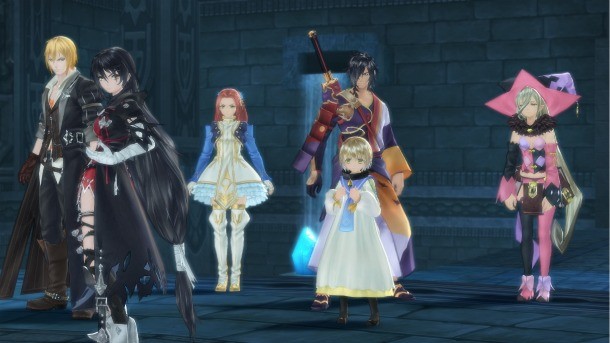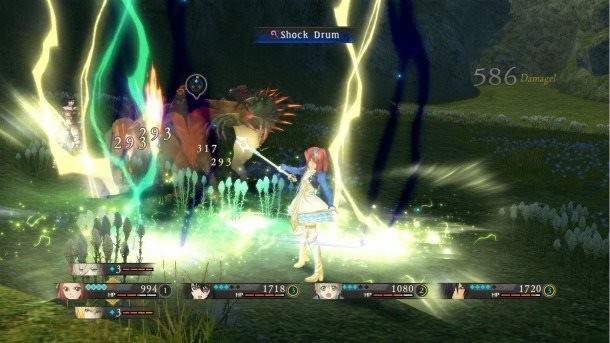Tales of Berseria Review

Tales of Berseria is the darkest Tales game, but it's also the most human. It tackles complex themes in relatable ways, like betrayal, revenge, and how pain brings out the worst in us. This makes it shine, and is a step in a right direction after coming off the disappointing Zestiria. However, Berseria still has its missteps when it comes to pacing and dungeon design. Even so, I liked the shift to a more somber tale that gave me plenty to think about during - and even after - the journey.
Berseria focuses on Velvet, a woman who has seen her share of tragedy. One devastating event sends her over the edge, beginning a deadly quest for revenge. The opening is powerful and grim, illustrating why Velvet turned into the hardened person that she is. She's not your typical Tales protagonist full of good deeds; she just wants vengeance, and most of the time she's downright cruel and cold in the process. I found this refreshing, because even when Velvet is at her worst, I still felt for her due to how well the game set up her backstory. Berseria has a lot of twists that I won't spoil, but Velvet meets other misfits and they uncover corruption as their world is overrun by demons.
While a revenge tale isn't new ground for storytelling, it still works for building up to key moments and making them relatable. Berseria is at its best when it shows the reasoning behind your allies' actions and developing them in interesting ways. For instance, watching one character who didn't have free will slowly turn into his own person is a highlight. You have a lot scenes and dialogue to shift through, and it's a slow burn, but it's worth it for how it all comes together. I wasn't even sure how I felt about the cast for the first 10 hours of the game, but the payoff is in how they grow and change.
When you're not bonding with your party, you're out on the battlefield. The action-based battle system has a lot of depth, and new wrinkles continue to be introduced well into the journey. Combat is all about exploiting enemy weaknesses and chaining combos. Everything revolves around a soul gauge, which depletes as you attack. I enjoyed strategizing around this because it forced me to make the most out of my every move. If your soul gauge is low, your attacks do less damage, are more easily defended, and leave you open to counterattacks. This means spamming the attack button is not in your best interest. You can restore the gauge by idling, or you can steal souls from enemies to refill it by stunning them, inflicting status effects, or defeating them, but beware your enemies can do the same.

This doesn't even factor in special attacks like powerful mystic artes or break souls, which have the power to extend combos and their power even when your gauge is running low. The battle system is all about making the most out of your soul gauge, and rewards you for doing so in how fast you can annihilate foes and in your loot drops. It took me a while to wrap my head around all its intricacies, but once I did, I had a blast pushing its limits. I also appreciated how easy all the special moves are to execute, and it helps that all your artes are on the face buttons.
Dungeons are still a struggle, filled with lots of boring busywork. You flip a lot of switches, break obstacles, and backtrack constantly. The environments themselves leave much to be desired, and sometimes you revisit dungeons and areas, which gets tiresome. The backtracking got on my nerves the most. You eventually get a hoverboard to quickly traverse areas, but this makes it harder to pick up items vital for crafting. In addition, you can purchase items to fast travel, but they only allow you go to certain points, which doesn't fix the problem.
About halfway through the game, you also get your own headquarters. At first, this seems cool, but Berseria doesn't do many exciting things with it. After every mission, you come back and chat with your party to plan your next move, but it settles into a boring rhythm quickly. The headquarters' layout is awful, making it inconvenient, and you're often required to go from one end to the other. You also have to battle through this area repeatedly.
As for bonus content, you have your own pirate ship, but you don't ever get to sail it yourself; you send your crew on expeditions to collect extra goodies for you like ingredients for cooking. The game also has its share of minigames and things to collect. I most enjoyed the bounty hunts and the side quests involving characters, such as one trying to get her comedy show off the ground.
Tales of Berseria does some interesting things, and is the most captivating Tales storyline in some time. I like the majority of its ideas, but the execution often feels half-realized. It still feels like the franchise isn't making big enough leaps, and is just content to bring its fans more of the same. By now, you probably know if you're okay with that. Nothing ever made me stop playing, but the flaws are impossible to ignore.

Get the Game Informer Print Edition!
Explore your favorite games in premium print format, delivered to your door.
- 10 issues per year
- Only $4.80 per issue
- Full digital magazine archive access
- Since 1991










